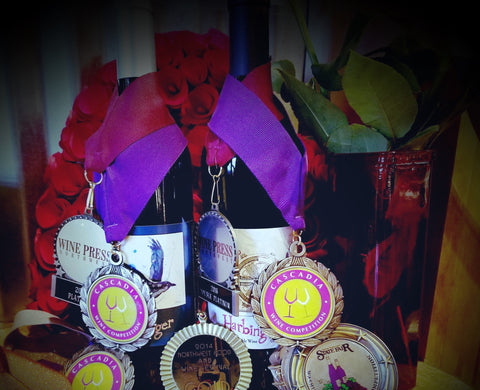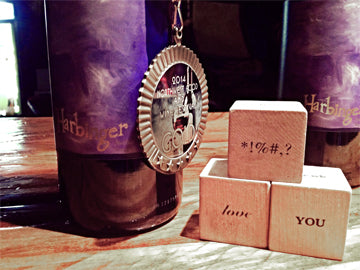 The Red Wine Cider & Chocolate Tour takes place over two enchanting weekends, and you’ll fall head over heals in love with the Olympic Peninsula Wineries & Cideries! The new wine releases and gastronomic offerings will satisfy every palate and have you wandering deeper into the fertile lands of Chocolatopia with every sip.
The Red Wine Cider & Chocolate Tour takes place over two enchanting weekends, and you’ll fall head over heals in love with the Olympic Peninsula Wineries & Cideries! The new wine releases and gastronomic offerings will satisfy every palate and have you wandering deeper into the fertile lands of Chocolatopia with every sip.
 The Dynamo Red (that's right our least expensive red) earned a PLATINUM medal and the 2012 Malbec pulled in a DOUBLE PLATINUM! We didn't even know such a thing existed...stop by the tasting room to try these wines and take a bottle home to enjoy and brighten up any evening.
The Dynamo Red (that's right our least expensive red) earned a PLATINUM medal and the 2012 Malbec pulled in a DOUBLE PLATINUM! We didn't even know such a thing existed...stop by the tasting room to try these wines and take a bottle home to enjoy and brighten up any evening.
Now that you’ve given the wine a good look, you’re ready to take a good sniff. Give the glass a swirl, but don’t bury your nose inside it. Instead, just hover over the top like a helicopter pilot surveying rush hour traffic. Take a series of quick, short sniffs, then step away and let the information filter through to your brain. There are many guides to help you train your nose to identify key wine fragrances, both good and bad. There are potentially thousands of aroma components in a glass of good wine, so forget about finding them all. Naming all the fruits, flowers, herbs and other scents you can trowel out of the glass can be a fun game, but it’s not essential to enjoying and learning how to taste wine. Once you’ve taken a few quick, short sniffs of the wine, try to look for the following aromas, which will help you better understand the wine’s characteristics. You also want to look for off-aromas that indicate a wine is spoiled.
There are many guides to help you train your nose to identify key wine fragrances, both good and bad. There are potentially thousands of aroma components in a glass of good wine, so forget about finding them all. Naming all the fruits, flowers, herbs and other scents you can trowel out of the glass can be a fun game, but it’s not essential to enjoying and learning how to taste wine. Once you’ve taken a few quick, short sniffs of the wine, try to look for the following aromas, which will help you better understand the wine’s characteristics. You also want to look for off-aromas that indicate a wine is spoiled.
Learning to identify these common flaws is at least as important as reciting the names of all the fruits and flowers. And it will also help you to understand your own palate sensitivities and blind spots. Discovering what you recognize and enjoy is key to learning how to choose wine on your own.
If there are no obvious off-aromas, look for fruit aromas. Wine is made from grapes, so it should smell like fresh fruit, unless it is very old, very sweet, or very cold. You can learn to look for specific fruits and grapes, and many grapes will show a spectrum of possible fruit scents that help you to identify the growing conditions—cool climate, moderate or very warm—of the vineyard.
Floral aromas are particularly common in cool climate white wines like Riesling and Gewürztraminer, and some Rhône varietals, including Viognier.
Some other grapes can be expected to carry herbal or grassy scents. Sauvignon Blanc is often strongly grassy, while Cabernet Sauvignon can be scented with herbs and hints of vegetation. Rhône reds often show delightful scents of Provençal herbs. Most people prefer that any herbal aromas are delicate. The best wine aromas are complex but also balanced, specific but also harmonious.
Another group of common wine aromas might be characterized as earthy. Scents of mushroom, damp earth, leather and stone/mineral can exist in many red wines. A mushroom smell can add nuance; it can also help you determine a possible grape or place of origin of the wine. Too much mushroom may just mean that the grapes failed to ripen sufficiently, or were from an inferior clone. Scents of earth, mineral and rock sometimes exist in the very finest white and red wines. These can be indications of “terroir”—the particular conditions of the vineyard that are expressed as specific scents and flavors in the finished wine.
If you smell toast, smoke, vanilla, chocolate, espresso, roasted nuts, or even caramel in a wine, you are most likely picking up scents from aging in new oak barrels. Depending upon a multitude of factors, including the type of oak, the way the barrels were made, the age of the barrels, the level of char and the way the winemaker has mixed and matched them, barrels can impart a vast array of scents and flavors to finished wines. Think of the barrels as a winemaker’s color palette, to be used the way a painter uses tubes of paint. Too much oak can be detrimental to a wine; imparting harsh bitterness and pencil lead flavors that mask the fruit.
Young white wines and young sparkling wines may have a scent very reminiscent of beer. This is from the yeast. Some dessert wines smell strongly of honey; this is evidence of botrytis, often called noble rot, and is typical of the very greatest Sauternes (a very expensive French wine).
Chardonnays that smell of buttered popcorn or caramel have most likely been put through a secondary, malolactic fermentation, which converts malic to lactic acids, softening the wines and opening up the aromas.
Older wines have more complex, less fruity aromas. A fully mature wine can offer an explosion of highly nuanced scents, beautifully co-mingled and virtually impossible to name. Nonetheless, the effort to put words to wine aromas helps you focus on, understand and retain your impressions of different wines. You want to build a memory bank of wine smells and their meanings. That is where the language of wine can add value to a wine tasting event. Learning to talk the talk, if not carried to extremes, helps to dispel some wine myths, such as the confusion surrounding descriptions on wine labels. Have you ever known anyone to ask why a winery added grapefruit to its Gewürztraminer and raspberries to its Zinfandel? The fact that these are simply descriptive terms is not always understood.
The information in this article was borrowed from Paul Greggut; Contributing Editor for Wine Enthusiast magazine, a founding member of the magazine’s Tasting Panel, and reviewer of the wines of Oregon and Canada. The author of the critically-acclaimed Washington Wines & Wineries—The Essential Guide, he consulted on the Pacific Northwest entries in current versions of The World Atlas of Wine and The Oxford Companion to Wine. Needless to say, Paul knows his stuff!

We are going to break this into 5 different postings as not to overwhelm everyone with too much information.See, Swirl, Sniff, Sip, Swallow, and Savor!
See: Just Look at the wine. What does the color tell you, and why do we care? Besides the obvious (it’s red, white, or rose’) the color can give you a few indicators of the wine. Holding the glass against a white backdrop helps to see the color more easily. Is it really dark, or is it easy to see through (Cabernet Sauvignon or Pinot Noir?)? If the wine was fermented in the skins (as most reds are), the color from the skin imparts color and flavor into the wine. Certain wines are naturally darker than others. For example, you can let the crushed grapes of Grenache or Pinot Noir sit in the skins for 3 weeks and it won’t impart much color while Malbec and Petite Verdot has the opposite effect: 3 days and the juice looks like ink. Does it have a brownish or brickish hue or is it a bright magenta-like color? This is an indicator of possible age or quality. A brownish edge means it may be an older wine, while magenta or bright purple exhibits youth.
How about those legs (what?)? These are the little rivulets that form when you swirl the glass and let the wine settle back down into the glass. Some say this gives you an indication of the thickness (or viscosity), or sweetness of the wine….a generally accepted rule is the closer the legs( or rivulets) form together the higher in alcohol the wine content. It could also mean your glass is dirty or has residue, so don’t put too much meaning into this.
How about oak? The newer the oak, the more color it helps the wine to retain. Or in a white wine it can actually give the wine a straw-like hue. Typically (but not always) you will find this color in a richer, more full-bodied white wine. If a white wine has less of a straw-like color chances are it is unoaked and is going to be brighter in flavor as oak subdues some of the acidity (more about that later).
With red wines, oak doesn’t impart a ton of color but it does help to lock in the color that is already there. Wines that easily lose their color (Barbera) benefit from aging in new oak. Oak-aging also allows for “controlled oxidation” to take place, which mellows out some of the harshness of red wines. With oxidation and/or age wine tends to inherit that brick-like color. And typically rose’-style wines are bright and crisp as they aren’t barrel-aged….unless you work at Harbinger Winery. We like the visual, aromatic, and palatial effects that a small amount of barrel-aging imparts on our rose’.
Are you thirsty yet? This is a good time to open your favorite bottle of wine (preferably Harbinger) and see it through your new eyes!
Stay Posted: Be on the lookout of what to do next…Swirl!!!
 SANTA ROSA, Calif. – A few from the Pacific Northwest earned gold medals or better at the 25th annual Grand Harvest Awards, which took place last week in the heart of Sonoma County wine country.
SANTA ROSA, Calif. – A few from the Pacific Northwest earned gold medals or better at the 25th annual Grand Harvest Awards, which took place last week in the heart of Sonoma County wine country.